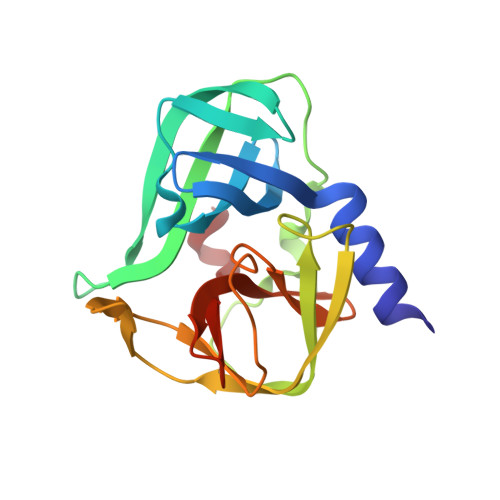Structure-assisted design of mechanism-based irreversible inhibitors of human rhinovirus 3C protease with potent antiviral activity against multiple rhinovirus serotypes.
Matthews, D.A., Dragovich, P.S., Webber, S.E., Fuhrman, S.A., Patick, A.K., Zalman, L.S., Hendrickson, T.F., Love, R.A., Prins, T.J., Marakovits, J.T., Zhou, R., Tikhe, J., Ford, C.E., Meador, J.W., Ferre, R.A., Brown, E.L., Binford, S.L., Brothers, M.A., DeLisle, D.M., Worland, S.T.(1999) Proc Natl Acad Sci U S A 96: 11000-11007
- PubMed: 10500114
- DOI: https://doi.org/10.1073/pnas.96.20.11000
- Primary Citation of Related Structures:
1CQQ - PubMed Abstract:
Human rhinoviruses, the most important etiologic agents of the common cold, are messenger-active single-stranded monocistronic RNA viruses that have evolved a highly complex cascade of proteolytic processing events to control viral gene expression and replication. Most maturation cleavages within the precursor polyprotein are mediated by rhinovirus 3C protease (or its immediate precursor, 3CD), a cysteine protease with a trypsin-like polypeptide fold. High-resolution crystal structures of the enzyme from three viral serotypes have been used for the design and elaboration of 3C protease inhibitors representing different structural and chemical classes. Inhibitors having alpha,beta-unsaturated carbonyl groups combined with peptidyl-binding elements specific for 3C protease undergo a Michael reaction mediated by nucleophilic addition of the enzyme's catalytic Cys-147, resulting in covalent-bond formation and irreversible inactivation of the viral protease. Direct inhibition of 3C proteolytic activity in virally infected cells treated with these compounds can be inferred from dose-dependent accumulations of viral precursor polyproteins as determined by SDS/PAGE analysis of radiolabeled proteins. Cocrystal-structure-assisted optimization of 3C-protease-directed Michael acceptors has yielded molecules having extremely rapid in vitro inactivation of the viral protease, potent antiviral activity against multiple rhinovirus serotypes and low cellular toxicity. Recently, one compound in this series, AG7088, has entered clinical trials.
Organizational Affiliation:
Agouron Pharmaceuticals, Inc., 3565 General Atomics Court, San Diego, CA 92121, USA. [email protected]















